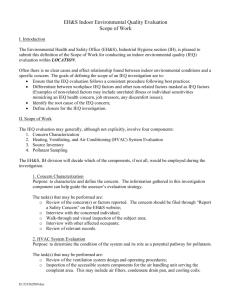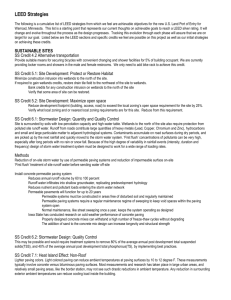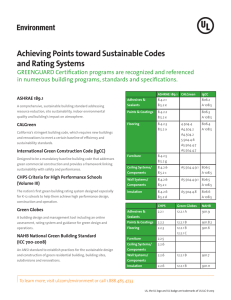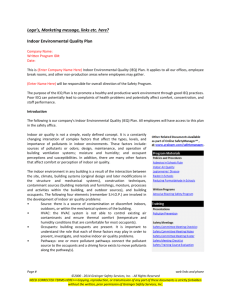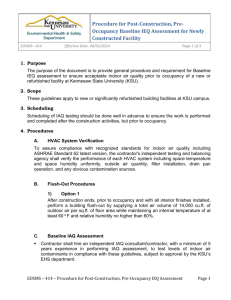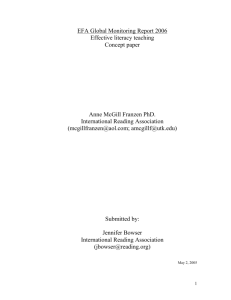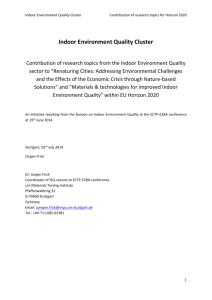IEQ and Productivity: Is there a link?
advertisement
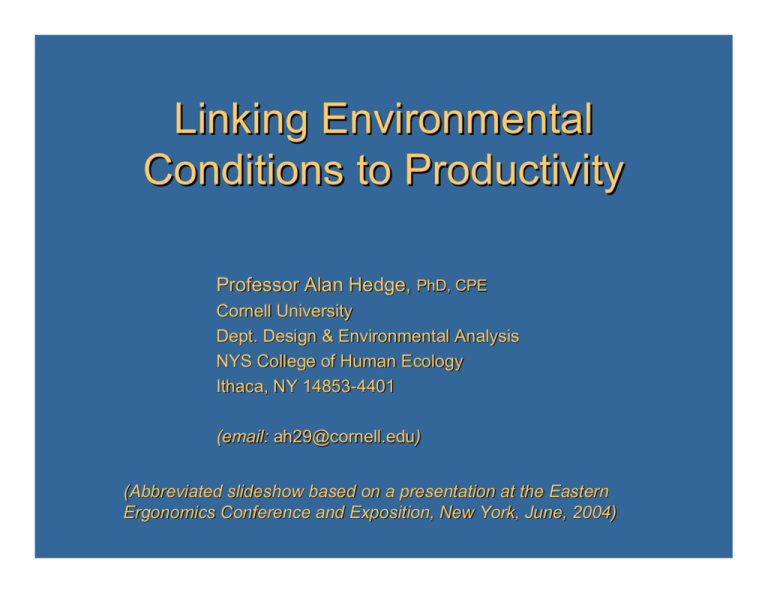
Linking Environmental Conditions to Productivity Professor Alan Hedge, PhD, CPE Cornell University Dept. Design & Environmental Analysis NYS College of Human Ecology Ithaca, NY 14853-4401 (email: ah29@cornell.edu) (Abbreviated slideshow based on a presentation at the Eastern Ergonomics Conference and Exposition, New York, June, 2004) IEQ Effects on Productivity z Scattered studies that mostly show evidence of an association between indoor environment conditions and some measure of performance. z Research issues: – – – – – – – Laboratory vs. field studies Single vs. multiple contaminants/conditions Surveys vs. interventions Short-term vs. longer-term Single exposure vs. multiple exposure Time-lagged effects Acute vs. chronic health effects IEQ Effects on Productivity System Heating, Ventilating and Air Conditioning System Environmental experience z z z z Thermal comfort Indoor Air Quality Background noise Mechanical vibration z Personal control/stress Productivity Impact z z z z z Performance decreases when too cold Performance decreases when too hot Performance decreases in polluted air Performance decreases when too noisy Performance decreases when person/equipment vibrates z Performance decreases with no control (perceived or real) IEQ Effects on Productivity System Lighting System Environmental experience z Illumination level/ distribution z Glare z Ambient/task systems z Color z Room ambience (shadows) z Personal control/stress Productivity Impact z Performance decreases when too dim or too bright z Performance decreases when too glaring z Task demands and user age change light requirements z Affective changes in environmental desirability z Disrupts visual inspection/ interpersonal interactions z Performance decreases with no control (perceived or real) IEQ Effects on Productivity System Sound conditioning system/ Acoustic design Environmental experience Productivity Impact z Background noise z Speech privacy/intelligibility z Noise stress z Personal control/stress z Performance decreases with loud/annoying noise z Performance decreases with poor privacy z Performance decreases with noise stress z Performance decreases with no control (perceived or real) IEQ factors and Human Performance Temperature - Hot - Cold Lighting - Bright - Dim - Glare Sound - Noise - Disturbance Productivity Indoor Air Quality - Acute - Chronic Personal Control Vibration - Segmental - Whole-body Optimal IEQ Conditions OPTIMAL IEQ Too cold Thermal conditions Too hot Too quiet Acoustic conditions Too loud Too dim Lighting conditions Too bright Indoor air quality Too polluted Vibration Too vibrating (Source: Stanton, Hedge et al. (2004) Handbook of Human Factors and Ergonomics, CRC Press) Productivity – Individual Work Performance z Productivity research traditionally has focused at the coarse, aggregate level of the building and the occupants. z Aggregate measures cannot define precise associations between IEQ conditions and individual productivity. z Laboratory studies have investigated performance and exposure to specific pollutants and mixtures, but exposures are short-term, non-cumulative and use simulated work tasks z Research need is to focus on the performance of the individual and the environment experienced by that the individual. z Individual measures: – Self-reports – Task Performance (time, accuracy, quantity, quality) IEQ and Productivity Research z New Research Approach – Combining spatiotemporal IEQ and Productivity Datasets – IEQ measure needs to include air temperature and relative humidity because thermal conditions are known to influence work performance, and consequently could confound any associations with air pollutants. – Most HVAC systems are designed to regulate thermal conditions, and HVAC systems respond to thermostat controls. – Thermal conditions impact levels of VOCs and other pollutants – Thermal conditions are an indicator of ventilation quality. High temperatures can indicate poor ventilation which in turn can indicate high pollutant loads. IEQ Data Logging z IEQ logging units that can be: – – – – – – – – Widely dispersed throughout a building Small size Silent operation Self-powered “Inexpensive” Frequent logging/data storage capabilities Ideally, work computer synchronized Ideally, collect data on a wide array of IEQ variables. Average Daily Temperature Pattern z Insurance company (Florida) – 9 workstations for 16 work days 46.0 44.0 Mean RH Average Daily Humidity Pattern z Insurance company (Florida) – 9 workstations for 16 work days 52.0 50.0 48.0 42.0 40.0 38.0 19:45:00.00 19:15:00.00 18:45:00.00 18:15:00.00 17:45:00.00 17:15:00.00 16:45:00.00 16:15:00.00 15:45:00.00 15:15:00.00 14:45:00.00 14:15:00.00 13:45:00.00 13:15:00.00 12:45:00.00 12:15:00.00 11:45:00.00 11:15:00.00 10:45:00.00 10:15:00.00 9:45:00.00 9:15:00.00 8:45:00.00 8:15:00.00 7:00:00.00 Time Electronic Productivity Measures z Keystrokes/errors/mouse activity z Utilize existing networked data collection software (EMS) z Data file – every work minute the software records a count of: – – – – Correct keystrokes Errors Mouse activity Longitudinal data (e.g. every 15 minutes for 16 days) Electronic Productivity Measures z Example of data structure (does not show errors column) 400 300 200 100 Mean Keystrokes per 15 minutes Average Daily Keying Pattern z Insurance company (Florida) – 9 workstations for 16 work days 500 0 19:45:00.00 19:15:00.00 18:45:00.00 18:15:00.00 17:45:00.00 17:15:00.00 16:45:00.00 16:15:00.00 15:45:00.00 15:15:00.00 14:45:00.00 14:15:00.00 13:45:00.00 13:15:00.00 12:45:00.00 12:15:00.00 11:45:00.00 11:15:00.00 10:45:00.00 10:15:00.00 9:45:00.00 9:15:00.00 8:45:00.00 8:15:00.00 7:00:00.00 Time Average Daily Mousing Pattern z Insurance company (Florida) – 9 workstations for 16 work days 60 40 Mean Errors per 15 minutes Average Daily Error Pattern z Insurance company (Florida) – 9 workstations for 16 work days 100 80 20 0 19:45:00.00 19:15:00.00 18:45:00.00 18:15:00.00 17:45:00.00 17:15:00.00 16:45:00.00 15:45:00.00 16:15:00.00 15:15:00.00 14:45:00.00 14:15:00.00 13:15:00.00 13:45:00.00 12:45:00.00 12:15:00.00 11:45:00.00 11:15:00.00 10:45:00.00 10:15:00.00 9:45:00.00 9:15:00.00 8:45:00.00 7:00:00.00 8:15:00.00 Time Keystrokes and Mousing z Insurance company (Florida) – 9 workstations for 16 work days 2500 Keystrokes per 15 minutes 2000 1500 1000 500 0 0 200 400 Mouse seconds per 15 minutes 600 800 Humidity and Keystrokes z Insurance company (Florida) – 9 workstations for 16 work days 2500 R Sq Linear = 0.001 Keystrokes per 15 minutes 2000 1500 1000 500 0 30.0 35.0 40.0 45.0 RH 50.0 55.0 60.0 Light and Keystrokes z Insurance company (Florida) – 9 workstations for 16 work days Temperature and Keystrokes z Insurance company (Florida) – 9 workstations for 16 work days 2500 R Sq Linear = 0.006 Keystrokes per 15 minutes 2000 1500 1000 500 0 19.00 20.00 21.00 22.00 23.00 TempC 24.00 25.00 26.00 Temperature and Errors z Insurance company (Florida) – 9 workstations for 16 work days R Sq Linear = 0.01 Errors per 15 minutes 300 200 100 0 19.00 20.00 21.00 22.00 23.00 TempC 24.00 25.00 26.00 Mouse Seconds Dependent Variable: Mouse Seconds 95% Confidence Interval Parameter B Intercept 176.333 Std. Error t Sig. Lower Bound Upper Bound 3.505 50.308 .000 169.461 183.206 Temperature2 (nTa°C) 5.325 2.301 2.314 .021 .814 9.836 RH2 (nRH) -.207 .101 -2.050 .040 -.405 -.009 Mouse seconds=176.33 + 5.33(nTa) 2 - .21(nRH)2 Note: Environment variables normalized Keystrokes Dependent Variable: Keystrokes 95% Confidence Interval Parameter Intercept B Std. Error t Sig. Lower Bound Upper Bound 204.522 5.411 37.798 .000 193.913 215.131 2.446 .348 7.029 .000 1.764 3.128 Temperature (nTa°C) 33.087 5.444 6.078 .000 22.413 43.761 Temperature2 19.306 4.373 4.415 .000 10.732 27.879 Light (nL) Keystrokes=204.52 + 2.45(nL)+ 33.09(nTa) + 19.31(nTa)2 Note: Environment variables normalized Error Keys Dependent Variable: Error Keys 95% Confidence Interval Parameter B Std. Error t Sig. Lower Bound Upper Bound Intercept 48.584 1.128 43.058 .000 46.371 50.796 Temperature (nTa°C) -3.694 .937 -3.941 .000 -5.531 -1.856 RH (nRH) .525 .188 2.800 .005 .157 .893 Light (nL) .716 .059 12.165 .000 .600 .831 Temperature2 2.021 .743 2.722 .007 .565 3.477 RH2 -.082 .032 -2.515 .012 -.145 -.018 Errors=48.58 – 3.69(nTa)+.53 (nRH)+.72 (nL) + 2.02 (nTa) 2 - .08 (RH)2 Note: Environment variables normalized Temperature and Performance 100 Keying Errors 90 80 Percent 70 60 50 40 30 20 10 0 20.6 21.0 21.3 21.7 22.1 22.5 22.9 23.2 23.6 Air Temperature (deg.C) 24.0 24.4 24.8 Temperature and Cost z Assumptions: Estimated Keying Error Costs per Hour (assuming $16/hr wage) 4.00 3.50 3.00 Lost Dollars – Employee earns $16 per hour – Keying time = 900-mouse time seconds – Total keys = correct + error keys – Cost/key = keying time/total keys – Error costs = error keys X costs per key – Hourly costs = 4 x error costs 2.50 2.00 1.50 1.00 0.50 0.00 20.6 21.0 21.3 21.7 22.1 22.5 22.9 23.2 Air Temperature (deg. C) 23.6 24.0 24.4 24.8 Research Conclusions z Results show clear associations between office work performance and indoor environment conditions z Results suggest that performance improves as conditions approach a predicted thermal comfort zone z Raising temperature from 20°C to 25°C: – – – – – Reduces energy consumption (less cooling) Reduces costs Reduces errors by 44% Increases keying output by 150% Saves ~$2.00 per worker in lost productivity z With optimization of other environmental conditions the cost savings will be even greater! Research Conclusions z Study confirms the utility of this new metric for assessing the performance and financial impacts of IEQ changes. z Associations between changes in specific indoor environmental variables and consequent productivity changes can now be investigated. z The impact of IEQ changes (e.g. different lighting, different HVAC systems) on productivity can now be tested. z The impact of any ergonomic changes (e.g. new chairs, new workstations, keyboard trays) on productivity can now be tested. z Data for IEQ standards that can incorporate productivity impacts can now be gathered. Questions
